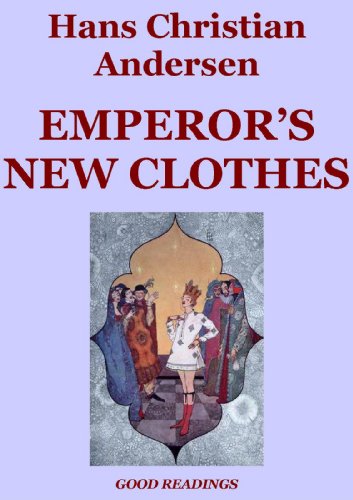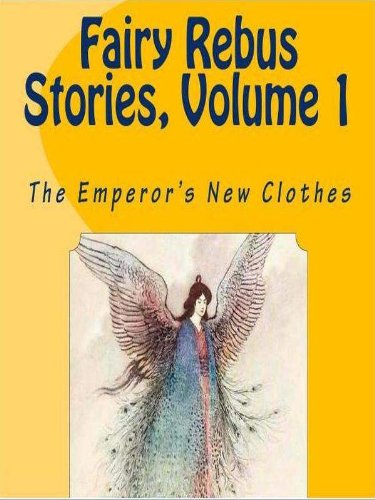-
The Emperor's New Clothes
Carl Sommer, Ignacio Noe
Library Binding (Advance Publishing, April 1, 2014)Sometimes people are willingly dishonest rather than risking embarrassment. Such is the case in this whimsical rendition of Hans Christian Andersens classic tale. Excessive fondness for elaborate and expensive clothing allows a pair of dodgy tailors to hoodwink the emperor. Weaving a grandiose tale instead of actual clothing, the tailors tell the emperor that their exquisite garments, woven with the finest of materials, are invisible to less worthy individuals. Reluctant to admit possible imperfections, no one in the town is willing to be honest, with the exception of one small boy. The conclusion of this tale extends beyond that of the original, shedding light on the benefits that come from always telling the truth. J
J
-
The Emperor's New Clothes
Hans Christian Andersen
eBookHans Christian Andersen was a Danish author best known for writing children's storiesincluding "The Little Mermaid" and "The Ugly Duckling." But he didn't just write short stories, and his intended audience wasn't restricted to children. In addition to his fairy tales, Andersen wrote poems, plays, novels, travel books, essays, and more. He hungered for recognition at home (Denmark) and abroad—and he got it! Eventually. Today, his stories can be read in over one hundred languages. But no matter what language they're in, Andersen's tales have got something for everyone. In them, you'll find beauty, tragedy, nature, religion, artfulness, deception, betrayal, love, death, judgment, penance, and—occasionally—a happy ending. They're complex tales, but since Andersen himself was pretty complex, we like to think that art imitates life. Or something like that. "The Emperor's New Clothes" is a short tale by Hans Christian Andersen about two weavers who promise an Emperor a new suit of clothes that is invisible to those who are unfit for their positions, stupid, or incompetent. When the Emperor parades before his subjects in his new clothes, no one dares to say that he doesn't see any suit of clothes until a child cries out, "But he isn't wearing anything at all!" The tale has been translated into over a hundred languages. Includes lovely illustrations! Reading books develops your imagination and improves intelligence!
-
The Emperor's New Clothes Collection
Hans Christian Andersen, Margot Kidder, Audio Holdings, LLC
Audible Audiobook (Audio Holdings, LLC, June 12, 2009)The Emperor's New Clothes is a classic account of a young boy's recognition of "wise cloth" for what it is. This story will entertain every child no matter what age, along with the many other stories in this collection.
-
Emperor’s New Clothes
Hans Christian Andersen, A.W. Bayes , Anne Anderson , Arthur Rackham, Vilhelm Pedersen , H.J. Ford , Harry Clarke , Henry H.B. Paull
language (, Nov. 23, 2012)“Emperor’s New Clothes” is a fairy tale by the Danish poet and author Hans Christian Andersen (1805-1875). It was first published in 1837; it was translated in English by Mrs. Henry H.B. Paull (1812–1888) in 1875.The ebook cointains the most beautiful illustrations by Vilhelm Pedersen (1820-1859), Arthur Rackham (1867-1939), Anne Anderson (1874-1930), A.W. Bayes (1832-1909), Harry Clarke (1889-1931), H.J. Ford (1860-1941).
-
The Emperor's New Clothes
Hans Christian Andersen
eBook (Laverock, Sept. 10, 2015)Classics by Hans Christian Andersen. Rabbit Ears Treasury of World Tales Volume 4 enlightens and entertains with these classic stories read by your favorite stars and featuring original music by some of today's greatest artists. This edition includes illustrations never published before.
-
The Emperor's New Clothes
Hans Christian Andersen, Mary Howitt, Susannah Mary Paull
Paperback (Independently published, Aug. 2, 2019)"The Emperor's New Clothes" (Danish: Kejserens nye klæder) is a short tale written by Danish author Hans Christian Andersen, about two weavers who promise an emperor a new suit of clothes that they say is invisible to those who are unfit for their positions, stupid, or incompetent – while in reality, they make no clothes at all, making everyone believe the clothes are invisible to them. When the emperor parades before his subjects in his new "clothes", no one dares to say that they do not see any suit of clothes on him for fear that they will be seen as stupid!"The Emperor’s New Clothes" was first published with "The Little Mermaid" in Copenhagen, by C. A. Reitzel, on 7 April 1837, as the third and final installment of Andersen's Fairy Tales Told for Children. S
S
-
THE EMPEROR'S NEW CLOTHES
Hans Christian Andersen, Ken Stiles
eBook (, Nov. 18, 2011)Fairy Rebus StoriesVolume 1THE EMPEROR'S NEW CLOTHESbyHans Christian AndersenRebus byKen StilesFairy Rebus StoriesThese rebus puzzle stories use little pictures for the sound of some of the words in the story instead of the meaning. For example, when the words be or bee are in the story, a little picture of a bee is used instead. Two sounds in the same word are joined by a plus sign "+". As in, for example, "B+4" for before. With a minus sign "-" take out the sound of the picture or letter. Capital letters sound like they are pronounced in the alphabet. (for example, "Y" for why, "T" for tea or tee, or "C" for see or sea, etc.) Likewise, numbers (for example, "2" for to, too, or two). Two or three pictures in a row stand for the plural of that word. Lowercase letters use a sound other than the way they are pronounced in the alphabet.Consult the glossary if you need help; the answer if completely stuck.Enjoy,Ken Stiles
-
THE EMPEROR'S NEW CLOTHES
Hans Christian Andersen, Ken Stiles
eBook (AUK Kids, Nov. 18, 2011)Fairy Rebus StoriesVolume 1THE EMPEROR'S NEW CLOTHESbyHans Christian AndersenRebus byKen StilesFairy Rebus StoriesThese rebus puzzle stories use little pictures for the sound of some of the words in the story instead of the meaning. For example, when the words be or bee are in the story, a little picture of a bee is used instead. Two sounds in the same word are joined by a plus sign "+". As in, for example, "B+4" for before. With a minus sign "-" take out the sound of the picture or letter. Capital letters sound like they are pronounced in the alphabet. (for example, "Y" for why, "T" for tea or tee, or "C" for see or sea, etc.) Likewise, numbers (for example, "2" for to, too, or two). Two or three pictures in a row stand for the plural of that word. Lowercase letters use a sound other than the way they are pronounced in the alphabet.Consult the glossary if you need help; the answer if completely stuck.Enjoy,Ken Stiles
-
The Emperor's New Clothes
Hans Christian Andersen, Michael Adams
Hardcover (Unicorn Pub House, Nov. 1, 1989)A retelling of the classic tale about the foolish and vain emperor S
S
-
The Emperor's New Clothes
Meredith Rusu, Eva Martinez, Carles Arbat
Library Binding (Children's Press, Feb. 4, 2020)Tales to Grow By will be the perfect companion in the exciting path of becoming, little by little, responsible and happy grownups. Fairy tales are stories that have been passed down through generations. Their ancestral wisdom offers readers a truthful and extensive portrait of human behaviors and human experiences. This is why fairy tales are the perfect tool to teach character education.Tales to Grow by is a new series of books that unlocks the power of fairy tales. Each tale is retold to highlight important emotions, feelings and attitudes of its characters. Beautiful illustrations make the story accessible to young readers. Questions throughout the book and backmatter written by a children´s therapist guide the educator through the story and allow the readers to get in touch with their own feelings and emotions. The mix of rich content and visuals allows our little readers to enjoy the magic of the stories while developing strong and independent character.In this tender retelling of the classic fairytale, children learn the importance of recognizing their feelings and expressing them with honesty. E
E
-
The Chinese Emperor's New Clothes
Ying Compestine, David Roberts
Hardcover (Harry N. Abrams, Dec. 26, 2017)Ming Da is only nine years old when he becomes the emperor of China, and his three advisors take advantage of him by stealing his stores of rice, gold, and precious stones. But Ming Da has a plan. With the help of his tailors, he comes up with a clever idea to outsmart his devious advisors: He asks his tailors to make “magical” new clothes for him. Anyone who is honest, the young emperor explains, will see the clothes’ true splendor, but anyone who is dishonest will see only burlap sacks. The emperor dons a burlap sack, and the ministers can’t help but fall for his cunning trick. N
N
-
The Emperor's New Clothes
Sindy McKay, Toni Goffe, Hans Christian Andersen
Hardcover (Treasure Bay Inc, Jan. 1, 2013)In this delightfully funny retelling of the classic story, the emperor hires two tailors to make him a new set of elegant and magical clothes - clothes that foolish people will think are invisible! When the emperor parades through town in his fine new clothes, while really just wearing polka-dotted shorts, only a child is willing to speak up and tell the truth. O
O